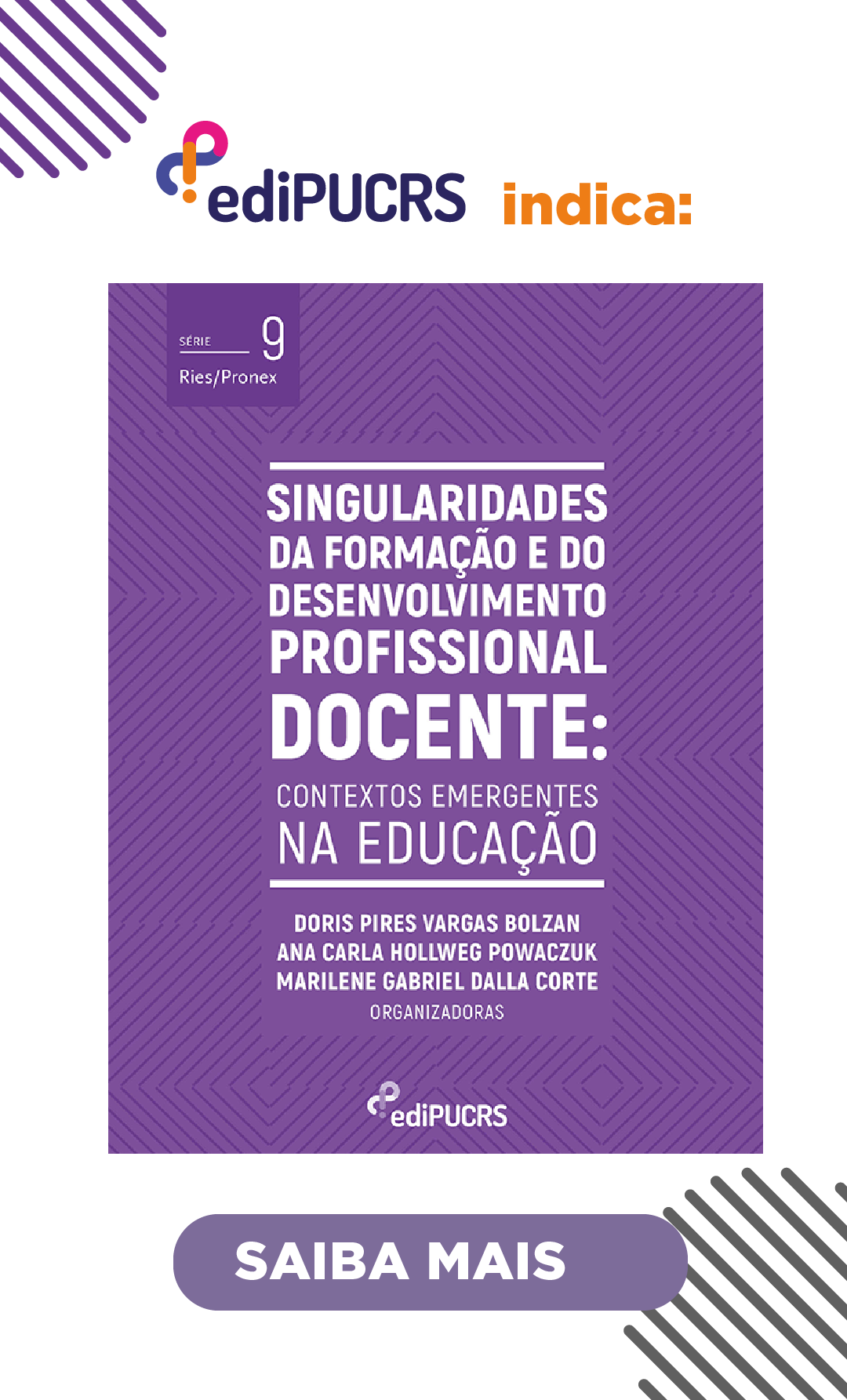Teaching beyond the vision: tools and strategies that support the inclusion of the visual impaired in a classroom
DOI:
https://doi.org/10.15448/2179-8435.2019.2.30304Keywords:
Inclusive Education. Visua impairment. Technological resources. Teaching.Abstract
The national education system is undergoing some changes in relation to teaching strategies and the approach of students in the classroom. The inclusion of students with some difficulties, among them the visual ones, focus of this writing, is a constant in the pedagogical environment. National legislation aims to guarantee the right of everyone to be included in society, without discrimination and in an integral and quality way. However, teachers still feel insecure, confrontation and some doubts about the inclusive process in the classroom. With the objective of identifying which resources the Universidade do Vale do Taquari (UNIVATES) offers to include students with visual impairment in the classroom, the present study has as a central theme the discussion about the educational resources for visually impaired students. The research methodology used was the study of cases, based on bibliographical research and research instruments, such as interview and questionnaire. The proposal involved professionals from UNIVATES, located in Lajeado-RS, who shared different situations experienced with students with visual impairment throughout a semester. The results of this research showed that, although the referred Higher Education Institution (IES) provides resources and tools that assist the visually impaired student in the classroom, it is still very low the adhesion of this public in technical and undergraduate courses.
Downloads
References
BRASIL. Lei nº 9.394. Lei de Diretrizes e Bases Curriculares. 20 de dezembro de 1996. Disponível em: www.planalto.gov.br/ccivil_03/leis/L9394.htm. Acesso em: 20 jul. 2017.
BRASIL. Lei nº 12.796. Constituição Federal da República Federativa do Brasil. 5 de outubro de 1988. Disponível em: www2.senado.leg.br/bdsf/bitstream/handle/id/518231/CF88_Livro_EC91_2016.pdf?sequence=1?concurso=CFS%202%202018. Acesso em: 2 ago. 2017. https://doi.org/10.11606/d.2.2010.tde-13122010-160747
BRASIL. Lei nº 13.146. Lei Brasileira de Inclusão da Pessoa com Deficiência. 6 de julho de 2015. Disponível em: www.planalto.gov.br/ccivil_03/_ato2015-2018/2015/lei/l13146.htm. Acesso em: 20 jul. 2017. https://doi.org/10.12957/polemica.2017.28294
BRASIL. Ministério da Educação. Diretrizes nacionais para a educação especial na educação básica. Brasília, DF: Secretaria de Educação Especial-MEC/SEESP, 2001. https://doi.org/10.17648/galoa-cbee-6-29723
CONFORTO, D.; SANTAROSA, L. M. C. Acessibilidade à Web: Internet para todos. Informática na Educação: Teoria & Prática, Porto Alegre, v. 5, n. 2, p.87-102, nov. 2002. https://doi.org/10.22456/1982-1654.5276
DIAZ, F. et al. Educação Inclusiva, Deficiência e Contexto Social: Questões Contemporâneas. Salvador, 2009. https://doi.org/10.7476/9788523209285
FERREIRA, A. M. Atividades de inclusão para alunos cegos e com baixa visão em aulas regulares de língua estrangeira. Universidade do Porto. Disponível em: repositorioaberto.up.pt/bitstream/10216/75212/2/28632.pdf. Acesso em: 8 ago. 2017. https://doi.org/10.17771/pucrio.acad.14243
FONSECA, J. J. S. Metodologia da pesquisa científica. Fortaleza: UEC, 2002. Apostila.
MANTOAN, M. T. E. Inclusão escolar – O que é? Por quê? Como fazer? São Paulo: Summus Editorial, 2003. (Coleção Novas Arquiteturas Pedagógicas). Disponível em: https://acessibilidade.ufg.br/up/211/o/INCLUS%C3%83O-ESCOLARMaria-Teresa-Egl%C3%A9r-Mantoan-Inclus%C3%A3o-Escolar.pdf?1473202907. Acesso em: 20 jul. 2017.
MANTOAN, M. T. E. O direito de ser, sendo diferente, na escola. In: III SEMINÁRIO INTERNACIONAL SOCIEDADE INCLUSIVA PUC MINAS – AÇÕES INCLUSIVAS DE SUCESSO. Anais... Belo Horizonte-MG, 2004. Disponível em: proex.pucminas.br/sociedadeinclusiva/sem3/maria_teresa_egler_mantoan.pdf. Acesso em: 8 ago. 2017.
NAP. Núcleo de Apoio Pedagógico. Entrevista pessoal. Lajeado: UNIVATES, 2017.
PASSERINO, L.; MONTARDO, S. P. Inclusão social via acessibilidade digital: proposta de inclusão digital para Pessoas com Necessidades Especiais (PNE). E-Compós, v. 8, 2007. Disponível em: aplicweb.feevale.br/site/files/documentos/pdf/40161.pdf. Acesso em: 8 ago. 2017. https://doi.org/10.30962/ec.v8i0.144
SANTOS, K. E. E. dos; BEHRENS, M. A. Quebrando paradigmas na educação: “o futuro” no presente. In: CONGRESSO NACIONAL DE EDUCAÇÃO – EDUCERE, X., PUCPR, Curitiba. 2011. Disponível em: educere.bruc.com.br/CD2011/pdf/5832_2949.pdf. Acesso em: 2 ago. 2017.
SCHENCKEL . M.; SOARES S. L. Ferramentas para deficientes visuais no estudo a distância utilizando o ambiente virtual de aprendizagem Moodle. Revista Interativa FAI, Itapiranga, n. 1, ano 2015. Disponível em: revista.faifaculdades.edu.br:8080/index.php/interativa/article/view/157. Acesso em: 2 ago. 2017. https://doi.org/10.5151/16ergodesign-0262
WERNECK, C. Ninguém mais vai ser bonzinho na sociedade inclusiva. 2. ed. Rio de Janeiro: WVA, 2000.
Downloads
Published
How to Cite
Issue
Section
License
Copyright (c) 2020 Educação Por Escrito

This work is licensed under a Creative Commons Attribution 4.0 International License.
Copyright
The submission of originals to Educação Por Escrito implies the transfer by the authors of the right for publication. Authors retain copyright and grant the journal right of first publication. If the authors wish to include the same data into another publication, they must cite Educação Por Escrito as the site of original publication.
Creative Commons License
Except where otherwise specified, material published in this journal is licensed under a Creative Commons Attribution 4.0 International license, which allows unrestricted use, distribution and reproduction in any medium, provided the original publication is correctly cited.





